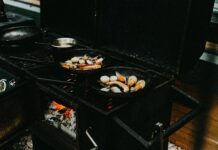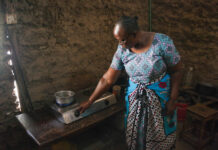By Fred Deya
Dairy farming is phenomenal in Kenya’s rift valley from homesteads of single lactating cow to large scale dairy farms for commercial purposes. But for the success of the business, certain factors are considerable.
Conducive environment with enough lighting system are mega boost for substantial milk production. Large scale milk production also needs processing machinery akin to solar powered milk cooling machine found at willy Kirwa’s farm.

For Willy Kirwa, a commercial dairy farmer from Kapseret village in Eldoret Sub County of Uasin Ngisu beats all odds by installing solar power system at his farm most specifically to power milk cooling machine and light the cattle shed while milking.
At the middle of Kirwa’s farm rests a spacious cattle shed that holds 60 dairy cattle, 30 lactating cows that are mooing at interludes giving an array that they are pressed for milking.
Inside the compound there is a house-like structure that shelters milk cooling facility that is directly connected to solar power source by power cables.
Inside the cattle pen, some power bulbs can be seen which after a couple of minutes are turned on to displace the darkness that begins to fall.
“I preferred using solar energy because it is natural and cheap to manage as compared to electricity that needs a lot of cash to install with monthly charges”, recites Kirwa.
Kirwa resorted to install 30 pieces of solar panel with different capacity outputs (100 Watts and 200 Watts).

After thorough consultation about the mega project, Kirwa rubbed shoulder with a group of people from USAID who visited his farm before installing the clean energy plant. The dairy farmer used a handsome amount of money to put up the project. Over Sh 4000000 ($40000) was spent for the entire project.
Kapseret resident confirmed the project lucrative and cheap even though the installation cost was much expensive but with a convincing fact that he gets free energy direct from the sun that will last for decades.
When asked why solar energy, he quickly pointed at his healthy hybrid cows saying, “”I majorly landed to install solar because I have got many dairy cattle and the milk production is high. Therefore I had to acquire milk processing machinery, which is milk cooling machine. I preferred to put up solar to run the machine because it is easy to handle and maintain which is also cheap”.
The solar produced power also lights cattle shed that is turned on during milking; very early in the morning and late very late in the evening after sunset.
According to dairy farmer light is preferred during milking in order to boost milk production in the sense that the strong light attracts lies that could sack cows during the milking process that make the restless.
Light also gives the cattle a worm and friendly environment hence makes them relaxed, added Kirwa.
The middle aged farmer told us that he started daily farming over ten years ago, an exercise that has really added penny in his pocket. Current his dairy milk production stands at 600 liters. He sales his produce locally and to the rift valley region milk suppliers. A liter of milk sales at Sh 30 ($0.3)
“I have to recommend the use of light at the cattle shed at all cost to other farmers in this village because it is advantageous to dairy farmers who expect high milk production”, said Kirwa.
Apart from lighting cattle shed, the produced energy is also used in light his main house. This has rescued him from expensive electricity which he thought of installing before solar project but backfired because he could not meet all the installation expenses.
For now the dairy farmer is green light relieved even planning to expand the solar plant for other domestic use. If he adds more panels, he will be able to start more parallel business like charging phones for people from their neighborhoods because many homesteads still have no access to electricity.
Kirwa’s home is not left out among places in in Kenya that have taken path of meeting the seventh of the sustainable Development Goals, that credits assurance of access to affordable, reliable, sustainable and modern energy for all.
Kirwa’s solar panels are connected in a way that they are easily hit directly by the sun (Photovoltaic), converting the sun rays into electricity.
Solar panels at the roof are directed connected to power storage solar batteries with power inverters that converts the direct current (DC) power generated by solar panels to Alternating current (AC) that is used on the grid.
According to the report Green Finance and Non-G20 Development Countries as was released by United Nation Environmental Program (UNEP) two month ago outlined the cost-effective rapid mobile banking that have been showcased in the country which at a good point is connected to solar energy installation to Kenya’s villages. Safaricom has been in the forefront to engage with solar panel companies like M-Kopa that offers pay- as- you go solar home systems.
UNEP’s tenth report revealed that $286 billion was totally spent in renewable energy in 2015, constituting 3 percent increase compared to what was spent back in 2011.
It is for the first time the renewable energy accounted for the most of the new electricity-generating capacity all over the world.
According to World Bank households, especially in the rural areas, are spending less on solar energy than they would on kerosene or electricity every two years. This estimates a full green energy revolution I the entire country in the near future.














